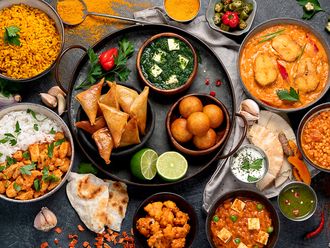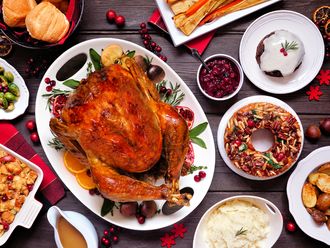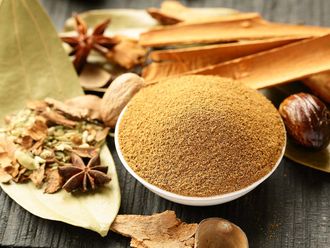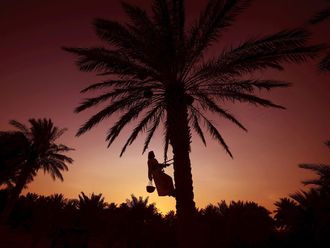Between the endless rows of glass doors encasing lavish gold jewellery, camel-themed souvenirs and traditional spices, for which iconic the Dubai Gold Souk is known, rests a decades' old food stall that tells the tale of the area and ‘Old Dubai’s’ history.
While the creek in the front of the market now overlooks the Burj Khalifa and the souk has transformed into a well-built marketplace, the hustle and bustle remains the same as it did when it first started. Shopkeepers are still bargaining with customers from far ends of the world, flocking to the City of Gold and at the end of a long day of negotiating with gold sellers and filling their tote bags with fridge magnets and keychains as souvenirs from Dubai, exhausted shoppers still swarm to Jafer Biman Ali Cafeteria as they did 65 years' ago.
Ice cold lemonade and juices rolling endlessly in juice dispensers, iconic to small cafeterias in the UAE, catch visitors’ eyes first but their special Iranian-style falooda, or faloodeh, keeps them coming back for more, according to the workers at the tiny juice stand that has stood at the same spot for over six decades.
A lemon-mint concoction, watermelon juice and a summer staple in the UAE – chilled laban are other favourites, especially when the mercury hits close to 50°C in the warmer months.
Shoppers and tourists are seen fanning themselves with shop brochures in front of the juice shop, holding a cold cup of faloodeh with chilled noodles swimming in a semi-frozen fragrant rose and lemon syrup – an Iranian speciality. A fan placed in front of each stall provides added relief.
Customers sip the fresh juices and fruit smoothies as they recount their day at the iconic souk and recap all they’ve shopped for.
The stall has been around since the 1950s and its workers have witnessed the different phases of changes the shop and area have gone through.
Mohammed Wasim, hailing from Pakistan, has worked at the shop for six years and he has already made plenty of friends in the area that has retained its community feel, which ‘Old Dubai’ is known for.
“The current owner has owned this shop for at least 45 years and shared with the workers that the stall was there when there were barely any other food shops nearby,” Wasim said.
The structure of the Gold Souk and the adjacent shops looked very different too at the time at which it started. According to Wasim, at first, the juice stand started out as a humble roadside stall and was owned by an Iranian expat in Dubai.
Now, the landscape of the area and the shop look very different. The bazaar has planned walkways, fans, benches, and air-conditioned gold and souvenir shops.
A karak chai gem tucked at the side of a mosque
While most of the features of the area have completely changed, culture, tradition and the essence of the place remain the same. As the loudspeakers convey the call to prayer five times a day, shopkeepers, visitors and residents of the lively Dubai Creek area and Al Ras District flock to the Bin Naeem Mosque, which is located right in the middle of the Gold Souk. It is also right next to the Museum of the Poet Al Oqaili, which is the former house of one of Dubai's most popular poets of classical Arabic poetry.
The mosque has a special feature, which mosquegoers and workers hold dear to their heart – the Shukrulla Al Haj Cafeteria.
Frequents to the area don’t leave without a hot cup of karak tea, accompanied by a “salam” (peace greeting) to the “Chacha” who serves it.
Mohammed Pakideeri, hailing from India’s Kerala, has served chai at the humble cafeteria, which is part of the mosque structure, for over 25 years.
The smiling 58-year-old is affectionately known as “Chacha or Chacha Mian” (which translates to uncle in Urdu and Hindi) by the frequent visitors and workers of the cafeteria, who raise their hands, signalling a greeting, every time they pass by the shop.
“I have lived alone in the UAE for over 25 years, my family resides back home in India. The workers of the cafeteria and the shopkeepers and stall workers from India, Pakistan and other countries have become my friends and family in the last three decades,” he said.
The same community feel and hospitality is exercised inside the glitzy gold shops. As shoppers pick out their favourite designs of jewellery, shopkeepers offer them a glass of fruit juice, cold water and a local favourite – karak tea.
These orders are placed at the Shukrulla Al Haj Cafeteria and other nearby food shops.
“We have a lot of people grabbing cups of tea as they visit the mosque, but most of our sales come from orders placed by the gold shops. We deliver tea and other refreshment drinks to them at their doorstep,” Pakideeri said.
It is known that the iconic Gold Souk is a symbol of all things glamour, which Dubai has to offer. But it’s not just the endless rows of glowing yellow that the market has to offer, it’s the relationships workers have made there working for decades, along with the historic food stalls that give visitors a unique experience.
If you want to get a feel of the marketplace from your home, here’s an easy recipe of the Iranian faloodeh, from the Jafer Biman Ali Cafeteria juice stall.
Ingredients:
A pack of cornstarch Iranian faloodeh noodles
1 tbsp sugar
1 cup water
Lemon syrup or 1 fresh lemon
Rose syrup
Method:
1. Mix the sugar with the water to create a simple syrup and freeze.
2. Boil the noodles till they are soft and rinse in cold water before putting them in the frozen syrup.
3. Drizzle lemon syrup and rose syrup on top and garnish with a lemon wedge. Enjoy the summery treat!
















